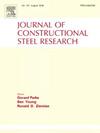Enhancing seismic performance of ductile linked rocking steel frames: A parametric investigation
IF 4
2区 工程技术
Q1 CONSTRUCTION & BUILDING TECHNOLOGY
引用次数: 0
Abstract
In a Ductile Linked Rocking Frame (DLRF) system, the steel braced frames remain elastic, incorporating Rocking Column Bases (RCBs) with coupon-type fuses at the horizontal rocking interface to facilitate uplift and rocking. This system is further enhanced by Corrugated Steel Panel (CSP) links, which are positioned along the vertical rocking interface. These CSP links act as additional structural fuses, dissipating energy and accommodating relative vertical movements between adjacent steel braced frames. This paper presents a numerical study to examine the seismic response of a typical DLRF and assess the influence of two key design parameters, the Self-Centering ratio (SC) and the Coupling Ratio (CR), on seismic-induced forces and drifts. A total of 40 prototype buildings, including two heights (4-storey and 8-storey) and various configurations of RCBs and CSP links, are analyzed using nonlinear time-history analysis in OpenSees with 22 far-field ground motions. The results indicate that an optimized DLRF configuration, especially with SC values in the range of 0.6 to 0.9 and CR values in the range of 0.5 to 0.6, achieves a uniform inter-storey drift distribution and negligible residual drift, even under Maximum Considered Earthquake (MCE) shaking. Finally, an improved capacity design procedure for DLRFs is proposed, which incorporates both SC and CR to guide engineering design.
提高延性链接摇摆钢框架的抗震性能:参数化研究
在延性连接摇摆框架(DLRF)系统中,钢支撑框架保持弹性,在水平摇摆界面结合带有折扣型保险丝的摇摆柱基座(RCBs),以促进隆起和摇摆。该系统通过波纹钢板(CSP)链接进一步增强,这些链接位于垂直摇摆界面上。这些CSP链接作为额外的结构保险丝,消散能量,并适应相邻钢支撑框架之间的相对垂直运动。本文通过数值研究,考察了典型DLRF的地震响应,并评估了两个关键设计参数,即自定心比(SC)和耦合比(CR)对地震诱发力和漂移的影响。总共40个原型建筑,包括两种高度(4层和8层)和各种配置的rcb和CSP链路,在OpenSees中使用非线性时程分析进行了22次远场地面运动分析。结果表明,优化后的DLRF结构,特别是当SC值在0.6 ~ 0.9范围内,CR值在0.5 ~ 0.6范围内时,即使在最大考虑地震(MCE)震动下,也能实现均匀的层间漂移分布和可忽略的残余漂移。最后,提出了一种改进的DLRFs容量设计方法,将SC和CR结合起来指导工程设计。
本文章由计算机程序翻译,如有差异,请以英文原文为准。
求助全文
约1分钟内获得全文
求助全文
来源期刊

Journal of Constructional Steel Research
工程技术-工程:土木
CiteScore
7.90
自引率
19.50%
发文量
550
审稿时长
46 days
期刊介绍:
The Journal of Constructional Steel Research provides an international forum for the presentation and discussion of the latest developments in structural steel research and their applications. It is aimed not only at researchers but also at those likely to be most affected by research results, i.e. designers and fabricators. Original papers of a high standard dealing with all aspects of steel research including theoretical and experimental research on elements, assemblages, connection and material properties are considered for publication.
 求助内容:
求助内容: 应助结果提醒方式:
应助结果提醒方式:


